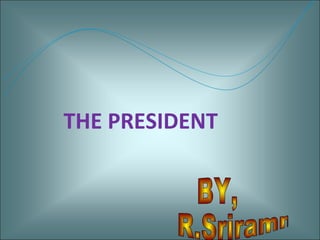
1.social ppt
- 2. Election procedure of the President of India The president of India not elected directly by the people. All the members of Parliament (MP) and members of Assemblies (MLA) elect him. A candidate standing for the post of President has to get majority of votes to win the election. This ensures that the President of India can be seen to represent the entire nation
- 3. Appointments made by the President of India 1. He/She appoints the Chief Justice of India, the judges of the Supreme Court and the High Courts of the states. 1. He appoints the Prime Minister of India and other ministers on the advice of the Prime Minister. He appoints the Governors of the States. 1. He appoints the Election Commissioners and Ambassadors to other countries
- 4. Powers of the President of India 1. The President of India is the head of the State. 2. He exercises only nominal powers. He is like the queen of Britain whose functions are to a large extent ceremonial. 3. The President supervises the overall functioning of all the political institutions. 4. All government activities take place in the name of the President 5. All laws and major policy decision of the government are issued in his/her name
- 5. 6. All major appointments are made in the name of the President. These includes the appointment of the Chief Justice of India, the Judges of the Supreme Court and the High Courts, the Governors of the States, the Election Commissioners, ambassadors to other countries etc.. 7. All international treaties and agreements are made in the name of the president. 8. The President is the Supreme Commander of the defence force of India
- 6. Limitation of the Power of President 1. The President is the head of the State and not the head of the government. Therefore, he exercises only nominal powers and that too on the advice of the council of ministers. 2. The President can ask the Council of Ministers to reconsider its advice. But if the same advice is given again, he/she is bound to act according to it. 3. A bill passed by the Parliament becomes a law only after the President gives assent to it. If the President wants, he/she can delay this for some time and send the bill back to the Parliament for reconsideration. But if the Parliament passes the bill again, he/ she to sign it
- 7. This model followed in most of the Latin America and many of the ex- Soviet Union countries Given the centrality of the President, this system is called Presidential form of Government But in India that follow British model, the parliament is Supreme and this system is called Parliamentary System of Government 11 / 2 8 /1 3
- 8. When and how does the President exercise his discretion? When a party or coalition of parties gets a clear majority in the elections, the President has to appoint the leader of the majority party or the coalition that enjoys majority support in the Lok Sabha When no party or Coalition gets a majority in the Lok sabha, the President exercise his discretion The President appoints a leader who in his opinion can muster majority support in the Lok Sabha. In such case, the President can ask the newly appointed to prove majority in the Lok Sabha within a specified time
- 9. When and how does the President exercise his discretion? When a party or coalition of parties gets a clear majority in the elections, the President has to appoint the leader of the majority party or the coalition that enjoys majority support in the Lok Sabha When no party or Coalition gets a majority in the Lok sabha, the President exercise his discretion The President appoints a leader who in his opinion can muster majority support in the Lok Sabha. In such case, the President can ask the newly appointed to prove majority in the Lok Sabha within a specified time